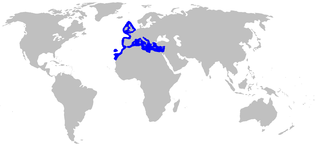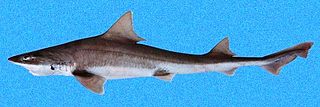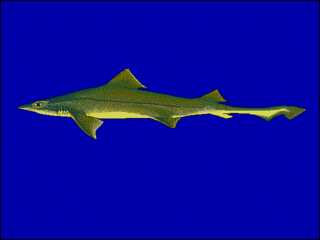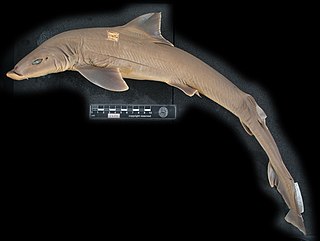Related Research Articles

The dusky smooth-hound, also called the smooth dogfish or the dog shark, is a species of houndshark in the family Triakidae. This shark is an olive grey or brown in color, and may have shades of yellow or grayish white. Females live to 16 years and males have a lifespan of 10 years. M. canis was the first shark recognised to have viral infections.

The school shark is a houndshark of the family Triakidae, and the only member of the genus Galeorhinus. Common names also include tope, tope shark, snapper shark, and soupfin shark. It is found worldwide in temperate seas at depths down to about 800 m (2,600 ft). It can grow to nearly 2 m long. It feeds both in midwater and near the seabed, and its reproduction is ovoviviparous. This shark is caught in fisheries for its flesh, its fins, and its liver, which has a very high vitamin A content. The IUCN has classified this species as critically endangered in its Red List of Threatened Species.

Rock salmon, also called rock eel, flake, huss or Sweet William, is a dish popular in Britain, based on shark, often served as part of a fish and chips dish.

Mustelus, also known as the smooth-hounds, is a genus of sharks in the family Triakidae. The name of the genus comes from the Latin word mustela, meaning weasel. It should not be confused with the genus name Mustela, which is used for weasels.

The Australian ghostshark is a cartilaginous fish (Chondrichthyes) belonging to the subclass Holocephali (chimaera). Sharks, rays and skates are the other members of the cartilaginous fish group and are grouped under the subclass Elasmobranchii. Alternative names include elephant shark, makorepe, whitefish, plough-nose chimaera, or elephant fish. It is found off southern Australia, including Tasmania, and south of East Cape and Kaipara Harbour in New Zealand, at depths of 0–200 m (0–656 ft).

The gummy shark, also known as the Australian smooth hound, flake, sweet william or smooth dog-shark, is a shark in the family Triakidae. These small to medium-sized bottom-dwelling sharks are found mostly in, but are not limited to, the area around the southern seas of Australia and is commonly baited and fished for cuisine because of its taste and market prices. According to a 2021 paper by White, Arunrugstichai & Naylorn (2021), Mustelus walkeri is the same animal as M. antarcticus. One theory is that M. walkeri is a subpopulation of M. antarcticus.

The spotted estuary smooth-hound or rig is a houndshark of the family Triakidae, found on the continental shelves and in estuaries around New Zealand. It is closely related to the gummy shark of Australia. Males can grow up to a length of 125 cm, while females can reach a length of 151 cm.

The common smooth-hound is a houndshark of the family Triakidae. It is found in the eastern Atlantic Ocean from the British Isles to South Africa, and in the Mediterranean Sea, Madeira, and the Canary Islands at depths ranging from 5 to 625 m. While they can grow to 200 cm, their usual maximum size is 150 cm. They commonly grow to 100–120 cm with a birth length around 35 cm. The reproduction of commons smooth-hounds is viviparous.

The whiskery shark is a species of houndshark in the family Triakidae, and the only member of its genus. This common shark inhabits the Australian continental shelf from Western Australia to the Bass Strait, to a depth of 220 m (720 ft). It is demersal in habits and prefers rocky and vegetated habitats. Stout-bodied and almost "humpbacked" in form, the whiskery shark can be distinguished from all other members of its family by the presence of long nasal barbels. Its two moderately large dorsal fins are roughly equal in size. It is brownish gray above and lighter below, with a pattern of darker saddles and blotches in younger sharks. This species reaches 1.6 m (5.2 ft) in length.

The sharptooth smooth-hound is a houndshark of the family Triakidae. It is found on the continental shelves of the tropical eastern Pacific from southern Mexico to Peru between latitudes 20°N and 5°S. Its length is up to 64 cm.

The brown smooth-hound is a houndshark of the family Triakidae. It is found on the continental shelves of the subtropical eastern Pacific, from northern California to the Gulf of California, as well as Ecuador and Peru between latitudes 43° N and 18° S, from the surface to a depth of 200 m. It can grow up to a length of 1 m. The reproduction of this shark is viviparous.

The sicklefin smooth-hound is a houndshark of the family Triakidae. Even some species look similar to Carcharhinus family, mustelus second dorsal fin is much bigger. It is found on the continental shelves of the eastern Pacific, between latitudes 33° N and 7° N. The difference between sharptooth smooth-hound and mustelus lunulatus, is that the lunulatus second dorsal fin origin far in advance of the anal fin. It can reach a length of up to 1.7 m. The reproduction of this shark is ovoviviparous.

The speckled smooth-hound is a houndshark of the family Triakidae. It is found on the continental shelf of the eastern Pacific, between latitudes 0° and 54° S, at depths between 16 and 50 m. It can reach a length of 130 cm (51 in). Collectively with certain other species of shark, it is known as "tollo".

The blackspotted smooth-hound is a houndshark of the family Triakidae found on the continental shelves of the subtropical eastern Atlantic from the Mediterranean to the Western Sahara, between latitudes 45 and 20°N, from the surface to a depth of 250 m. It can reach of a length of 1.5 m.

The humpback smooth-hound is a species of houndshark and a part of the family Triakidae.The most noticeable difference between Mustelus whitneyi and its relatives, is the slight curvature, causing a "humpback" appearance located in front of its primary dorsal fin. It is found on the continental shelves of the tropical southeast Pacific, from Peru to southern Chile, between latitudes 3° S and 54° S. These sharks are demersal feeders but range from depths between 15 and 210 metres. Humpback smooth-hound sharks are small sharks, reaching a maximum size of 118cm in total length. Mustelus whitneyi typically feed on teleosts and invertebrates in the benthic and pelagic ecosystems, most important prey being the peruvian anchovy. These humpback smooth-hound sharks are placental viviparious sharks, meaning that the embryo forms inside the mother tethered by the placental cord. The threats currently causing population decline to humpback smooth-hound sharks surround issues with local fisheries and management.

The southern sleeper shark or Whitley's sleeper shark is a deepwater benthopelagic sleeper shark of the family Somniosidae found in the southern Atlantic, Indian, and Pacific Oceans.

The Australian grey smooth-hound or also known as the grey gummy shark is a species of houndshark classified under the large family Triakidae. It is one of the twenty-eight species belonging to the genus Mustelus, which are often small in length. While members of the genus Mustelus may be found globally in tropical and temperate waters, the grey gummy shark in particular is native to the Pacific Ocean and Indian Ocean waters surrounding Australia and is particularly widespread in deep coastal waters. The grey gummy shark is known to be a viviparous species and gives birth to live young. With little data available, it is regarded to have a relatively stable population and possesses little threat to humans.
The eastern spotted gummy shark is a species of houndshark in the family Triakidae, found in Australian waters. It is a relatively large species.
The western spotted gummy shark is a species of houndshark in the family Triakidae, found in Australian waters. This new species of gummy sharks is a relatively large species.

Shark meat is a seafood consisting of the flesh of sharks. Several sharks are fished for human consumption, such as porbeagles, shortfin mako shark, requiem shark, and thresher shark, among others. Shark meat is popular in Asia, where it is often consumed dried, smoked, or salted. Shark meat is consumed regularly in Iceland, Japan, Australia, parts of India, parts of Canada, Sri Lanka, areas of Africa, Mexico and Yemen.
References
- ↑ Walker, T.I. (2016). "Mustelus antarcticus". IUCN Red List of Threatened Species . 2016: e.T39355A68634159. doi: 10.2305/IUCN.UK.2016-1.RLTS.T39355A68634159.en . Retrieved 11 November 2021.